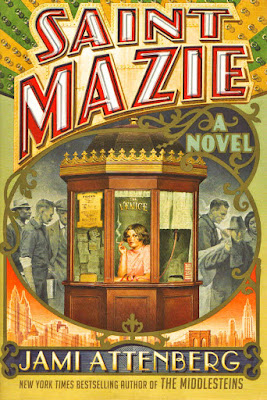I have written about,
and always been a fan of, Joseph Mitchell of The New Yorker. Now a new
book takes a real character from Mitchell’s writing and develops a
fictionalized life for her. That
character is Mazie Phillips, chief proprietress of the Venice movie theater in the Bowery in lower Manhattan and the novel
is called Saint Mazie (Grand Central
Publishing, 2015) by Jami Attenberg.
Mitchell is known for often bending the rules of nonfiction: compositing characters, condensing time
lines, and even injecting a fictionalized version of himself into his
work. However, Mazie Phillips was real,
and she is an intriguing and complex character both in Mitchell’s work and in
the novel.
First, some
true-to-life Mazie is in order. Mitchell calls her “A bossy, yellow-haired blonde” in his piece published on the pages
of the magazine in 1940. She fled her
hometown of Boston and the difficult life she had there accompanied by one
sister to go and live in New York with yet another sister and her husband. It is the husband, Louis, who owns the
theater. To earn her keep, she goes to
work in the ticket booth, the cage, as a teenager and for years she is an
institution in the neighborhood, helping down-on-their-luck drunks through
prohibition, the Great Depression, and two world wars. Mitchell captures the taste and heft of those
days, as he was most famous for doing in all of his pieces for the magazine. The theater is open every day from eight in
the morning until midnight. Mazie works
the cage while the very small staff work the house, cleaning and polishing the
old theater to accommodate the bums and dreamers who frequent the showings. For a dime, patrons can see two movies, a
newsreel, a cartoon selection, a short, and a serial episode. The place was warm and dry, and often, if a
bum didn’t have the price of admission, Mazie would let him in anyhow. She also was free with her change, handing
out nickels, dimes and quarters to those in need of a cup of coffee or a
sandwich. Step out of line meant
incurring the wrath of Mazie, and she had no qualms about marching into the
theater in the middle of a show to escort some miscreant out to the street,
berating him all the while.
Over the years, she
develops relationships with a local order of Catholic nuns who patrol the
streets of the Bowery looking to aid and assist the downtrodden. She also knows all the local merchants, and
she frequents them to share gossip and stories.
She also knows the places that serve alcohol during those dry days of
prohibition. Mitchell is so good at
drawing characters in his writing. He is
at heart a storyteller, so his essays burst with color and character, and his
story of Mazie is a classic in his oeuvre.
Jami Attenberg builds
on Mitchell’s work to present a unique and full novel, fleshing out the
characters that The New Yorker piece
only mentions in passing. She also
utilizes a particular narrative technique similar to an oral history. I was reminded most often when reading her
writing of Studs Terkel and his oral histories.
She eschews the standard narrative for passages in Mazie’s unpublished
autobiography and diaries, as well as transcribed interviews with key
characters in her life and times. By
piecing together clues from each person’s account of the story, a full picture
emerges that in the end is both sad and complete, an entire history of a time
and place long crumbled into the dust of years.
As she is in Mitchell’s piece, Mazie is a strong and memorable
character. Attenberg’s work only deepens
Mitchell’s because it focuses on her life behind the public face, bringing into
the character the details the experiences that made Mazie the truly memorable
person she was.
What is truly
successful about the novel is that we get to see those other characters that
walk the fringes of Mitchell’s story.
The Catholic nuns, for example, are given names and character, and we
see the unlikely friendship between the Jewish Mazie and the nun called Sister
Tee develop into grudging respect and intimacy.
It is a poor, drug-addicted mother who brings them together in the first
place so that they can save the lives of her two children. Unfortunately, only one can be saved while
the other is lost in the system. There
is a good ending to the story, however, later in the novel.
Jami Attenberg
captures the tone and environment of the Bowery in her novel. The characters are sepia-toned and full of
life, like a lyrical history that takes the reader beyond facts and
statistics. Like Mitchell, she has a
gift of establishing true and memorable characters. Mazie, of course, is a force to be reckoned
with as she is in the source material from the magazine. For those interested in Mitchell’s profiles,
or who love character-driven stories, Saint
Mazie is an excellent read and a beautiful story. The author pays homage to Joseph Mitchell,
storyteller of 20th century New York and deepens the tale of Mazie
Phillips, queen of the Bowery, rescuer of the fallen.
Note: For those interested in reading a complete
collection of Joseph Mitchell’s writing for The
New Yorker, including Mazie’s story, check out Up In The Old Hotel (Vintage, 1993).


No comments:
Post a Comment
I would love to know who is commenting. Therefore, please use the selections below to identify yourself. Anonymous is so impersonal. If you do not have a blog or Google account, use the Name/URL selection. Thanks.